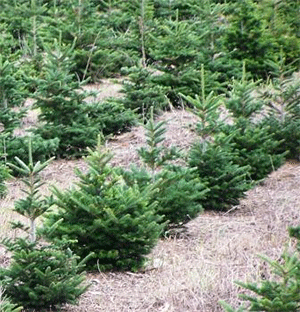By Richard Jauron
The holiday season is almost here, and with it comes Christmas tree season. Having a fresh-cut Christmas tree is a popular tradition, but it can come with some issues regarding proper selection and care. Matching the right tree to the right home environment is crucial.

Iowa State University Extension and Outreach horticulturists can help answer questions about Christmas trees and how to handle them this holiday season. To have additional questions answered, contact the ISU Hortline at 515-294-3108 or hortline@iastate.edu.
What decisions should be made before purchasing a Christmas tree for the holidays?
A few decisions should be made before going out to purchase a Christmas tree. Decide where you are going to place the tree in the home. Be sure to choose a location away from heat sources, such as a fireplace or radiator. Also, decide on the size (height and width) of the tree that you want. Finally, decide where you are going to purchase the tree.
Christmas trees may be purchased from cut-your-own tree farms or as cut trees in commercial lots. A list of tree farms in your area can be found at the Iowa Christmas Tree Growers Association website.
What types of trees are available?
Tree species commonly available at tree farms and commercial lots in Iowa include Scotch pine, white pine, red pine, Fraser fir, balsam fir, Canaan fir, Douglas fir, white spruce and Colorado spruce.
How can I determine the freshness of a cut Christmas tree?
Freshness can be determined with a few simple tests. Gently run your hand over a branch. The needles on a fresh tree will be pliable. Those on a dry tree will be brittle. Another test is to lift the tree by the trunk and lightly bounce the butt on the ground. Heavy needle drop indicates a dry tree. A fresh tree will drop only a few needles.
What is the best way to store a cut Christmas tree?
If you don’t intend to set up the Christmas tree immediately, place the tree in a cool, sheltered location. An unheated garage or shed is often a suitable storage site. (The sun and wind dries out trees stored outdoors.) Put the butt of the tree in a bucket of water. Remove an inch or more from the bottom of the trunk before bringing the tree in the house. A fresh cut facilitates water uptake.
Should I add any material to the water to prolong the freshness of my Christmas tree?
Do not add molasses, sugar, soft drinks, aspirin or commercial products to the water. Additives provide no real benefit. The keys to keeping a Christmas tree fresh are to place the tree away from any heat source (fireplace, heater, radiator, etc.) and keep the tree reservoir full of water. Check the tree reservoir at least once or twice a day. Fresh trees absorb large quantities of water (especially in the first few days). If the water level drops below the bottom of the trunk, water uptake will be drastically reduced when the reservoir is refilled. As a consequence, the tree will dry out more quickly because of poor water uptake.
How long can a cut Christmas tree remain in the house?
The length of time a cut Christmas tree can remain in the home is determined by the tree species, the freshness of the tree at purchase, and its placement and care in the home. In general, a fresh, well-cared-for Christmas tree should be able to remain in the home for three to four weeks. Remove the tree from the house when its needles become dry and brittle.
Source: iastate.edu